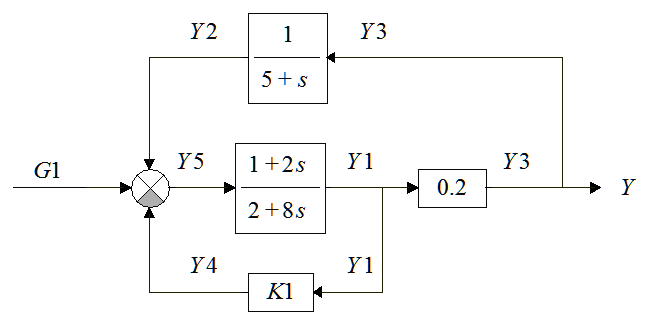Theoretical analysis of the system at the initial time in the following sequence:
1. The values of all parameters are calculated from the time-dependent graphs at t = 0.
2. Transfer functions are replaced by the gains from the values calculated by finding the limit when p = ∞ and equal bn / an, where n - the order of the transfer function.
3. Determine the value of the output of the system, which can be calculated either by obtaining the transfer function of the entire closed-loop system, followed by multiplying the value of the input action, either by obtaining the equations of output-input followed by obtaining expressions for the exit. Other signal values are calculated by multiplying the known signal by the gain level if it is in the course of the flow signal, or dividing by a gain level if Calculating occurs in the opposite direction.
Theoretical analysis of the final time in the following sequence:
1. The values of all parameters are calculated from the time-dependent graphs at t = ∞.
2. Transfer functions are replaced by the gains from the values calculated by finding the limit at p = 0 and equal to b0 / a0.
3. Determine the value of the output of the system, which can be calculated either by obtaining the transfer function of the entire closed-loop system, followed by multiplying the value of the input action, either by obtaining the equations of output-input followed by obtaining expressions for the exit. Other signal values are calculated by multiplying the known signal by the gain level if it is in the course of the flow signal, or dividing by a gain level if Calculating occurs in the opposite direction.
An example of a theoretical analysis of the system.
Block diagram of the system under study is shown in Figure 22.

Figure 22. Block diagram of the system under study
Feature G1(t) is shown in Figure 8, and the characteristic K1(t) in Figure 9. Then, at the initial time a block diagram of the system takes the following form (see. Figure 23).
Figure 23. Block diagram of the system under study at the initial time
Then, the output value of the Y can be determined in two ways:
1). Y=3*W=3*(W1,4*W3/(1-W1,4*W3*0))=3*((W1/(1+W1W4))*W3)=
=3*((0.25/(1+0.25*3))*0.2)=0.15/1.75=0.085714.
2). Y=Y3=W3*Y1;
Y1=W1*Y5=W1*(3-Y4+0*Y3)=W1*(3-W4*Y1) => Y1=3*W1/(1+W1*W4)=3*0.25/(1+0.25*3)=0.75/1.75;
Y=Y3=0.2*0.75/1.75=0.15/0.75=0.085714.
Consequently, the other signals of the system are:
Y1 = Y3 / W3 = 0.085714/0.2 = 0.42857;
Y4 = 3*Y1 = 3*0.42857 = 1.28571;
Y2 = 0*Y3 = 0;
Y5 = 3 - Y4 + Y2 = 3 - 1.28571 + 0 = 1.71429.
In the final time a block diagram of the system takes the following form (see. Figure 24).
Figure 24. Block diagram of the system under study at the final moment
Then, the output value of the Y can be determined in two ways:
1). Y=4*W=4*(W1,4*W3/(1-W1,4*W3*W2));
W1,4=W1/(1+W1W4)=0.5/(1+0.5*5)=0.5/3.5;
W1,4,3=W1,4*W3=0.1/3.5;
Y=4*(W1,4,3)/(1-W2*W1,4,3)=4*(0.1/3.5)/(1-0.2*0.1/3.5)=0.4/(3.5-0.02)=0.4/3.48=0.114942.
2). Y=Y3=W3*Y1=W3*W1*Y5=W3*W1*(4+Y2-Y4)=W3*W1*(4+W2*Y3-Y1*W4))=W3*W1*(4+W2*Y3-W4*Y3/W3));
Y3=4*W1*W3 + W1*W2*W3*Y3 - W1*W4*Y3;
Y3 - W1*W2*W3*Y3 + W1*W4*Y3 = 4*W1*W3;
Y3 = 4*W1*W3 / (1-W1*W2*W3+W1*W4);
Y3 = 4*0.5*0.2 / (1-0.5*0.2*0.2+0.5*5) = 0.4/(1-0.02+2.5)=0.4/3.48=0.114942.
Consequently, the other signals of the system are:
Y1 = Y3 / W3 = 0.114942/0.2 = 0.57471;
Y4 = 5*Y1 = 3*0.57471 = 2.87355;
Y2 = 0.2*Y3 = 0.0229884;
Y5 = 4 - Y4 + Y2 = 4 - 2.87355 + 0.0229884 = 1.1494384.
After modeling system product SimACS be received transition processes, which are presented in Figure 25.
Figure 25. Transients systems and their coordinates
After analyzing the data obtained in the experiment (the first and last column), with the data obtained theoretically calculated relative error as a difference between the experimental unit and the theoretical value, divided by the module the theoretical value. Thus, the relative error of the output signal is less than 0.0001% and is associated with the use of theoretical calculations, the rounding operation.